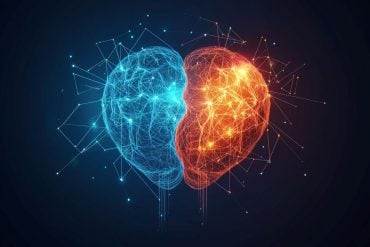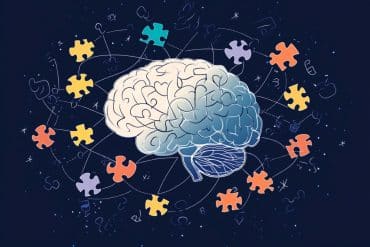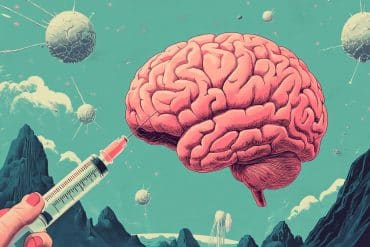Summary: A new study reveals how depression affects brain activity in the basolateral amygdala (BLA) of rats. Using a microelectrode array, researchers found increased theta frequency activity in the BLA correlated with depressive behaviors.
These findings could pave the way for targeted treatments for depression. The research highlights the potential of specific brain activity as a biomarker for depression.
Key Facts:
- Increased Theta Activity: Linked to depressive behaviors in the basolateral amygdala.
- Innovative Monitoring: Used a microelectrode array to track real-time brain activity.
- Therapeutic Potential: Findings could lead to targeted treatments for depression.
Source: Beijing Institute of Technology Press
A significant new study published in the Cyborg Bionic Systems journal by Fanli Kong and colleagues sheds light on the intricate relationship between depression and brain activity, particularly focusing on the basolateral amygdala (BLA) in rats.
This research offers compelling insights into how depression can alter neural circuits and could pave the way for new treatments.
Depression is a debilitating mental health issue affecting millions worldwide and is known for symptoms like persistent sadness, loss of interest in enjoyable activities, and fatigue. While traditional treatments have focused on neurotransmitters in the brain, this study dives deeper into the brain’s structural responses to depressive states.
The research team utilized an innovative microelectrode array (MEA) specifically designed to conform to the BLA’s anatomy. This device was crucial in monitoring the neural activity in rats induced into a depressive state using lipopolysaccharide (LPS), a compound known to trigger immune responses and mimic symptoms of depression.
The findings revealed that the rats exhibited increased neural activity in the theta frequency band within the BLA after LPS administration. This increase correlated with the animals displaying behaviors typically associated with depression, such as reduced exploration and decreased preference for sweetened water, an indicator of anhedonia—a core symptom of depression.
What makes these findings particularly groundbreaking is the detailed observation of how specific brain regions react to depressive conditions. The theta activity noted in the BLA could serve as a potential biomarker for depression, suggesting that treatments targeting this specific activity could be more effective.
Moreover, the study utilized sophisticated imaging and data analysis techniques, allowing the researchers to observe changes in real-time and with high precision. This approach not only increases the understanding of depression’s underlying mechanisms but also highlights the potential for developing more targeted and effective therapeutic strategies.
This research is a step forward in the fight against depression, providing a new perspective on how our brains react to the disorder. It opens up avenues for new research into specific brain activities associated with various emotional and psychological conditions, potentially leading to breakthroughs in how we treat them.
The implications of these findings are vast, suggesting that future treatments could be developed to target specific neural activities, potentially offering more effective relief for the millions suffering from depression worldwide. As research continues, the hope is that these insights will lead to more personalized and precise interventions, significantly impacting mental health treatment.
About this depression and neuroscience research news
Author: Ning Xu
Source: Beijing Institute of Technology Press
Contact: Ning Xu – Beijing Institute of Technology Press
Image: The image is credited to Neuroscience News
Original Research: Open access.
“Microelectrode Arrays for Detection of Neural Activity in Depressed Rats: Enhanced Theta Activity in the Basolateral Amygdala” by Fanli Kong et al. Cyborg and Bionic Systems
Abstract
Microelectrode Arrays for Detection of Neural Activity in Depressed Rats: Enhanced Theta Activity in the Basolateral Amygdala
Depression is a common and severely debilitating neuropsychiatric disorder. Multiple studies indicate a strong correlation between the occurrence of immunological inflammation and the presence of depression. The basolateral amygdala (BLA) is crucial in the cognitive and physiological processing and control of emotion.
However, due to the lack of detection tools, the neural activity of the BLA during depression is not well understood. In this study, a microelectrode array (MEA) based on the shape and anatomical location of the BLA in the brain was designed and manufactured.
Rats were injected with lipopolysaccharide (LPS) for 7 consecutive days to induce depressive behavior. We used the MEA to detect neural activity in the BLA before modeling, during modeling, and after LPS administration on 7 consecutive days.
The results showed that after LPS treatment, the spike firing of neurons in the BLA region of rats gradually became more intense, and the local field potential power also increased progressively.
Further analysis revealed that after LPS administration, the spike firing of BLA neurons was predominantly in the theta rhythm, with obvious periodic firing characteristics appearing after the 7 d of LPS administration, and the relative power of the local field potential in the theta band also significantly increased.
In summary, our results suggest that the enhanced activity of BLA neurons in the theta band is related to the depressive state of rats, providing valuable guidance for research into the neural mechanisms of depression.







